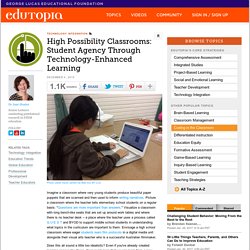

QR Codes in the Classroom. Learner Agency, Technology, and Emotional Intelligence. Preface Early in my training as an educator, I was exposed to William Glasser’s conceptualization of basic human needs and their importance in creating a healthy educational setting.

They are: Belonging – Fulfilled by loving, sharing, and cooperating with othersPower – Fulfilled by achieving, accomplishing, and being recognized and respectedFreedom – Fulfilled by making choicesFun – Fulfilled by laughing and playing They resonated deeply and made sense to me. Instructional strategies and learning activities should build in ways for learners to get these needs met.
The needs of freedom and power are of special note to this essay/topic: Freedom – This is the need to choose how we live our lives, to express ourselves freely, and to be free from the control of others. What is learner agency? Schwartz and Okita developed the following table to compare and contrast high versus low agency learning environments. TPACK.ORG.
SAMR Model examples. Louise Hall Prezi for TIP model. High Possibility Classrooms: Student Agency Through Technology-Enhanced Learning. Imagine a classroom where very young students produce beautiful paper puppets that are scanned and then used to inform writing narratives.

Picture a classroom where the teacher tells elementary school students on a regular basis: "Questions are more important than answers. " Visualize a classroom with long bench-like seats that are set up around work tables and where there is no teacher desk -- a place where the teacher uses a process called Q U E S T and BYOD to support middle school students in understanding what topics in the curriculum are important to them. Envisage a high school classroom where eager students learn film protocols in a digital media unit alongside their visual arts teacher who is a successful Australian filmmaker. Does this all sound a little too idealistic? Even if you've already created learning spaces like these, there is lot more that we can learn from a new study of Australian school classrooms.
"Figure 1" Image credit: Jane Hunter The 5 Conceptions "Figure 2" 1. Don’t Say “Agency” Unless You Really Mean It – sonya terborg. The IBO recently shared a graphic as part of it’s work in revamping the Primary Years Programme.

To be clear: This is their communications graphic illustrating the new organizing structure; not the new programme model. Agency (Voice, Choice, and Ownership) feature heavily. As I looked at this and thought about each of these components of agency, I imagined what I might look for in a classroom in which this existed. Webinar Today's Meet. Webinar Padlet. IB Webinar Survey: Models. AnswerGarden Poll. What is your favorite digital tool?

20 characters remaining pearltreespuppet pals Share Share this AnswerGarden on various social networks using the following buttons. Embed Use this link to refer to your AnswerGarden. Embed your AnswerGarden on your website or blog (640x400): MicroGarden MicroGarden is a very compact HTML5 answer field for AnswerGarden which can be used to gather user data. More information Export Tweet the results on TwitterExport the answers to WordleExport the answers to TagxedoTranslate the answers with Google Translate Get the questionGet the answersGet number of answersGet complete data chunkShow QR code Statistics Created: 18th of March 2017 19:24Question: What is your favorite digital tool?
Show and Scan! Answergarden.ch/454795 Local Discoverability Please confirm your password to access the admin panel for this AnswerGarden. Administration About | Search | Support | Feedback | Terms | 2017 © Creative Heroes. Reflection Voicethread. Common Sense Education. The EdTech Roundup. Educational Technology and Mobile Learning. Free Technology for Teachers.
Research: Social bookmarking. Self-management: Centers and LMS. Thinking: Surveys, polls, and quizzes. Communication: Website and eportfolio makers. Thinking: Game-based learning. Digital Storytelling. Peer collaboration. Global collaboration. Authentic resources. DiY. Makerspaces and Coding. Avatars.